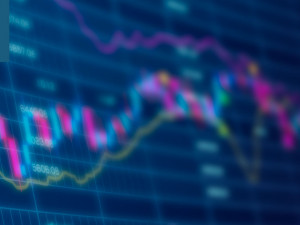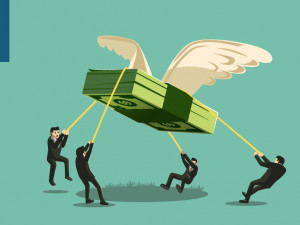
Sterling dam bursts
Morning mid-market rates – The majors
26th April: Highlights
- Bailey shows concerns about rapid rate hikes
- Economy continued to slow in March. Fed unlikely to be moved
- Don’t be fooled by the Eurozone’s slow emergence from the Pandemic
Pound likely to hit 1.25 and divergence emerges
The Governor of the Bank of England has already expressed his fears that hiking rates too quickly will slow the economy to such an extent that the Central bank will actually contribute to the overall malaise facing the economy, rather than achieving its goal of lowering inflation.
Rising inflation has led to a fall in retail sales as household budgets have been hard hit, causing consumers to be more considerate in making purchases. Online sales have been particularly badly hit, as the country’s emergence from the pandemic also contributes to a slowdown of shopping via the internet.
Despite the drop in retail sales, falling by 1.4% in February, they were still 2.2% above pre-Covid levels according to the Office for National Statistics.
The rising inflation crisis looks set to continue as factory gate prices were cited by manufacturers as a significant contributor to price rises according to flash data released yesterday.
The raising of spirits created by the full reopening of the economy has now dissipated, and firms are beginning to take a more cautious approach to hiring.
This may take a little steam out of the wage inflation that was beginning to creep into the economy, and may see any change to monetary policy at next week’s MPC meeting be the last for a month or two.
Output expectations are moving in the opposite direction to input costs and this concern is affecting investment intentions across both manufacturing and services.
One brighter spark came from the lessening of supply chain difficulties, but the greater availability of qualified drivers has to a large extent been negated by the rise in the cost of fuel.
The bleak beginning to the second quarter has hit the pound hard. Support levels that were considered to be fairly solid have been washed away, and the pound looks set to weaken further. It has fallen against both the dollar and euro in recent days.
Versus the dollar, the pound fell to a low of 1.2697 yesterday, closing at 1.2737, while versus the single currency it closed at 1.1894 having touched 1.1846 earlier.
If next week’s Central Bank meetings lead to further divergence the pound could fall further versus the dollar, and if the ECB turns more hawkish the recent low for sterling versus the euro will also be tested.
Considering your next transfer? Log in to compare live quotes today.
Growth beginning to slow but FOMC now committed
It may therefore become a concern to some that the economy is beginning to slow, according to regional activity surveys that have been released recently.
Both the Chicago and Dallas indexes saw falls; Chicago from 0.54 to 0.44, although this was still better than market expectations, while the Dallas Fed Manufacturing Business Index collapsed from 8.7 to 1.1. This was against a prediction of a rise to 11.4.
Over the past few weeks, FOMC members have been becoming increasingly hawkish in their comments about fighting inflation. It has now become the core expectation that the neutral rate for the Fed Funds Rate is 2.50% and there have been predictions that that level will need to be exceeded to bring inflation under control.
Speaking at the IMF last week, Jerome Powell seemed to almost commit his colleagues to a pair of fifty basis point hikes at the next two meetings.
This along with the expected commencement of a reduction in the Bank’s balance sheet is being seen as possibly overkill as the slowing of economic activity will also contribute to a fall in inflation despite the continuing rise in the cost of energy.
The U.S is insulated to a large extent from the rise in fuel prices, having come close to being neutral in the oil market, moving between being a net exporter and net importer month by month.
Having alluded to the issue recently, concerns are growing about the threat of further shutdowns in China that will further exacerbate the continuing difficulty with supply chains.
On the flip side, China’s recent voracious appetite for energy imports may see the wholesale price of gas begin to moderate, particularly as the Northern Hemisphere moves into summer.
There are growing fears that the potential slowdown in the economy is manifesting itself first in a downturn in the transport sector, trucking rates remain very high and this is a contributing factor to an approaching trucking recession. Rates are beginning to fall and the ability of truckers to dictate their own terms no longer apply. This may be an early warning of what is to come, and the FOMC would do well to heed this hidden warning.
The dollar index made another high for the year yesterday, reaching 101.86. It closed at 101.74 and may see further gains hard to achieve as the market slows in advance of the Fed meeting.
But economy cannot ignore Ukraine influence
There is little doubt that prior to the conflict in Ukraine beginning, the economy was beginning to pick up and this encouraged investors to believe that the recession that was on the horizon even before the Pandemic could be avoided.
Data file at the end of the first quarter adds to that level of expectation, but as the level of support being given to Ukraine as well as the effect of sanctions enacted against Russia begin to have a major effect, a slowdown through the current quarter is not only likely but almost certain.
Encouraging data releases for March are not quite being ignored, but they are doing little more than slow the expected fall in output.
Emmanuel Macron proved himself to be sufficiently humble to admit that his victory in the French Presidential Election was not especially due to his policies or even his personality. It was, in the main, almost a protest vote against his opponent.
In the end, the French electorate decided that a lurch to the right was not going to sole France’s domestic troubles, and although there was general distaste over Macron cosying up to the Russian President, it was generally put down to his desire to be at the forefront of Eurozone Foreign Policy where the majority of the French electorate believe is where France should be.
Macron’s new term in office is expected to see him open the coffers and enact some policies he promised the first time around.
Although close to half his first term was blighted by the pandemic, the French economy is slowing dramatically and inflation is growing. While France remains close to the bottom of the Eurozone’s inflation league, prices are beginning to rise at an alarming rate and this is one area where Le Pen was considered ahead of Macron since the President’s vision is often focussed outside French borders.
ECB President Christine Lagarde has performed an almost complete volte face regarding inflation.
Having spent most of her time promoting continued support for the economy in recent weeks, she is now expressing dire concerns about inflation. While she is not yet in Jerome Powell’s league, she is becoming more hawkish about rising prices.
It is now expected that the end of the current bond purchase programme will lead to the first rate hike of a new cycle.
The euro continues to be battered by the dollar. Yesterday, it fell to a low of 1.0696, closing at 1.0714.
As the ECB turns a little more hawkish, traders may see that the divergence between U.S. rates and Eurozone rates may not be so stark, and this may slow the fall in the value of the single currency.

About Alan Hill
Alan has been involved in the FX market for more than 25 years and brings a wealth of experience to his content. His knowledge has been gained while trading through some of the most volatile periods of recent history. His commentary relies on an understanding of past events and how they will affect future market performance.”



